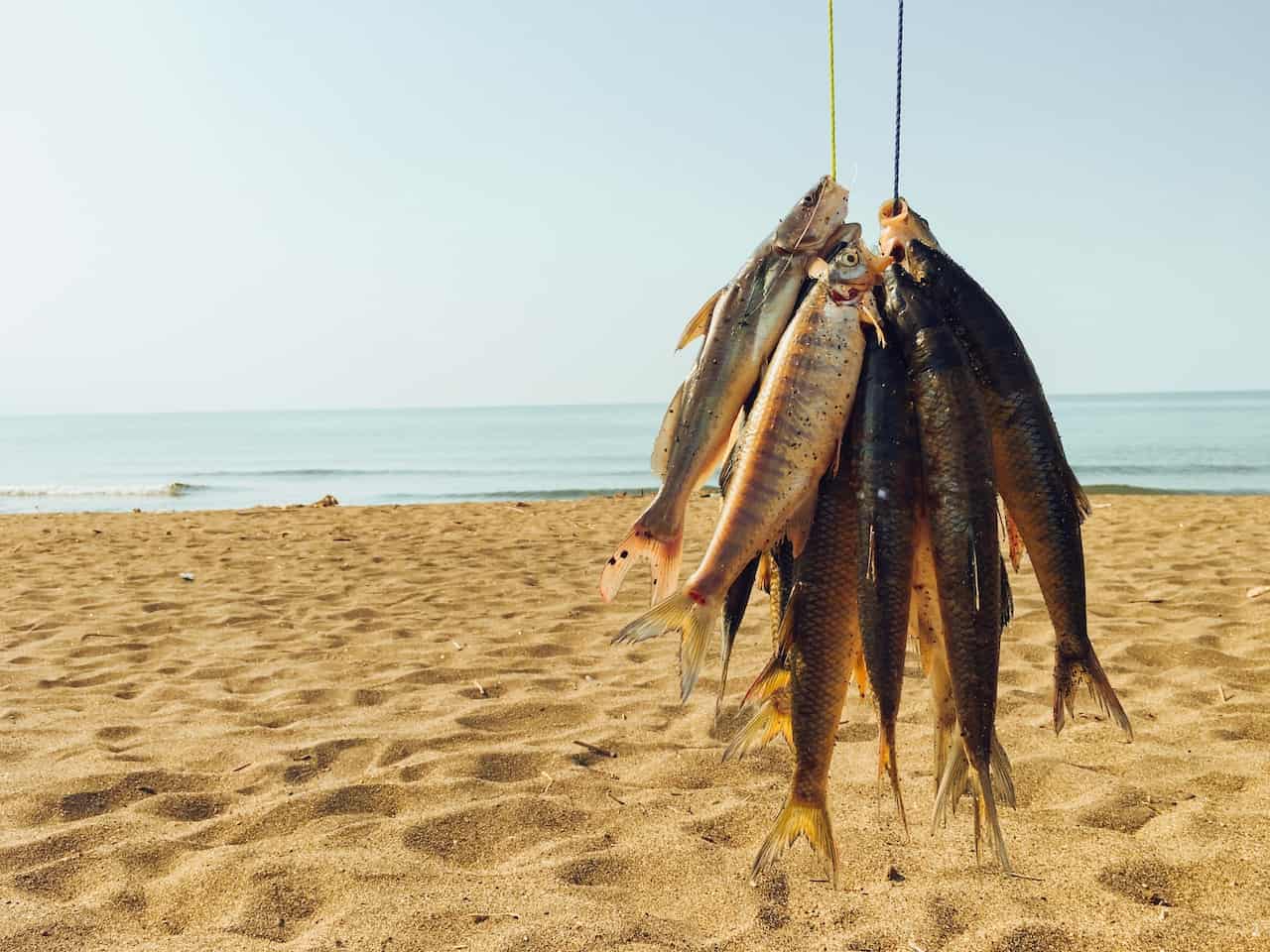Capturing fish while surf fishing is an intimidating task. Undeniably, it takes a lot of hard work and effort to get a great catch.
However, there is another challenge that begins after you successfully land your catches: You should figure out where and how to store them!
Fish are among the most perishable aquatic animals. They are highly susceptible to germs and bacterial growth. For this reason, they decompose and become rotten quicker than red meat and green veggies.
Therefore, it is important to store fish thoughtfully after you catch them so they don’t get spoiled.
That’s what this article is all about.
Today, we will discuss the most popular methods to keep fish while surf fishing and the different tools you need to keep your catches fresh and edible.
So let’s dive in.
How long do fish stay fresh out of water?
Well, several factors dictate the answer here, but air temperature is the one you should consider the most.
As a rule of thumb, you should expect bacterial growth to start within a few minutes of the catch. In other words, the longer you wait to store your fish, the higher the risk of it decomposing and becoming spoiled.
Now, in warm conditions, this process takes less time and therefore requires faster actions.
The amount of oils and fat in fish is also an important factor.
As a general rule, fatty fish with high oil/fat intake rot quickly as soon as they are taken out of the water. Conversely, low-fat fish stay fresh longer.
This explains why oily fish like trout, sardines, and mackerel take only a few minutes to rot while lean species such as striped bass and redfish last more than an hour in a pleasant state.
The takeaway here is that you have very little time. You should store your fish properly as soon as you land them on shore. The more you wait, the more bacteria will be in your food 😉
How to keep fish while surf fishing?
After discussing the importance of proper fish keeping when surf fishing and how long it takes for fish to rot out of water, it is now time to list some methods you can follow to bring fresh, healthy food to your dinner table.
I. Ice Method
Icing is undoubtedly the most primitive, yet most effective method of preserving fish and keeping them fresh for as long as possible.
Immerse the fish into a basket full of ice, but don’t lay them flat. In other words, position the fish as if they are swimming. This proved to make them last longer.
When storing over 2-3 fishes in a single basket, maintain a suitable distance between them. The goal is to create enough room for the ice to cover the entire body of each stored fish.
As a general rule, use double the weight of ice for every pound of fish you store. If the fish you are keeping weigh 30 pounds, use 60 pounds of ice. Here, be sure to favor crushed ice over large blocks. Crushed ice is more effective because it covers the whole bodies of the fish and therefore protects them better. Over time, as the ice melts, keep pouring more ice.
Unfortunately, ice melts faster when smashed than when in large blocks. That’s where insulated bags and coolers can come in handy.
Insulated fish bags and coolers are usually made of polyester and strong plastic exteriors, which prevents ice from melting and preserves it for several days. They also come in different shapes and sizes. All in all, it’s a brilliant investment, especially when you choose something that’s easy to carry around and suits your purposes and conditions very well.
II. Corning Method
Corning is another famous storage practice that has proven to be very effective when surf fishing. It’s a successful alternative to icing, especially in warm temperatures where ice takes very little time to melt.
Properly applied, the corning method can keep your catches fresh for up to 24 hours.
To corn your catches, you will need to pour a lot of fine-grained salt on them and store them in a covered container. Why salt? Because salt helps absorb water and oil inside fish, which slows down the decomposition process.
Ok, but how much salt is needed?
Well, no less than 5-6% of the weight of the fish.
This means that if you want to store a 20 pound striper, add about 1 pound (16 ounces) of salt to it and be sure to cover the entire body of the fish and focus more on the belly section.
If you can’t measure the amount of salt, keep adding until you’re 100% sure you’ve exceeded the required amount.
Once done, cover the fish with a semi-wet (damp) cloth, and keep it inside the container.
If you opt for the corning method, be sure to wash the fish thoroughly in clean water before cooking them. This helps get rid of all the salt you added and therefore improves the taste of the fish. Another way to remove salt is to soak the fish in a bucket of clean water for about 2 hours before cooking.
III. Bury the fish in the sand
When there is no salt or ice available, some anglers bury their fish in the sand to keep them fresh and slow down the decomposition process.
I have to say it’s not the best way to keep fish when surf fishing, but it does help keep the fish cool and out of the sun for a few hours.
I would only recommend this method in cold weather and when you won’t be on the beach for a long time. Keeping fish under the sand is fine for a few hours, but it certainly won’t work for the entire day.
A big downside to using the burying method is that you may have to pay a cost with the fish’s weight. Oftentimes, buried fish lose weight quickly when buried in sand, which can be disappointing to see.
Also, burrowing is not a brilliant method if you’ve caught a highly perishable species like mackerel.
While burying, put the fish in a plastic bag and tie it to something heavy. This marks where you buried the fish, which helps to find it easily later on.
Note that burying the fish in the swash zone (where the water stops) is much more efficient and keeps the fish fresh and cool longer. However, it is much easier to lose the fish there due to the continuous wave action.
Should you clean the fish before storing it?
Using the above methods will surely help keep your fish fresh and healthy, but a simple pre-cleaning process will give you better results.
The thing to know here is that the internal organs and gills of the fish are the first to deteriorate and form bacteria. Removing these parts before storing the fish will delay spoilage for a few more hours and thus reduce the risk of bringing rotten food home.
To clean your fish, cut the belly section vertically with a sharp knife, spread the body open, and then cut out and remove all organs, intestines and entrails from the anal section. After that, scrape off any mucus, slime, or black tissue and rinse the internal cavity of the fish with cool water.
The process shouldn’t take more than 2 minutes, but it will have a huge positive impact on the freshness of your catch.
Last word
Overall, ice is your best friend if you want to keep fish fresh while surf fishing. Investing in insulated bags and coolers is very worthwhile if you are planning to fish the surf on a regular basis and bring a lot of food from the beach.
That being said, the corning method is also an excellent alternative, especially when done well and in the right conditions. Burying fish in the sand can also be helpful, but I don’t recommend it in hot conditions and for long fishing trips.
Now, regardless of the method you choose, regular inspection is always essential.
In other words, when surf fishing, you should develop the habit of always checking your catches and seeing if they are still fresh. Discoloration, milky appearance, fishy smell, or ammonia smell, to name a few, are some red flags that the fish have gone bad. If you find rotten fish, immediately remove them from the basket. Remember that one rotten fish is enough to ruin all your catches.
Finally, if you do not have what it takes to properly store the fish, do not hesitate to put them back in the water. There’s no reason to bring home your fish if they aren’t healthy and fresh. So better take a few pictures and let the fish go back to the water!
Some recommended surf fishing gear(*)
Note (*): If you make a purchase through links from this website, we may get a small share of the sale from Amazon or other similar affiliate programs.
Surf Fishing Survey
Help us provide you with better content by answering simple questions about your surf fishing experience and knowledge.
We will put the collected responses together and turn them into valuable information that will help you catch more fish from shore 😉
Note: No personal information will be collected with your answer.


